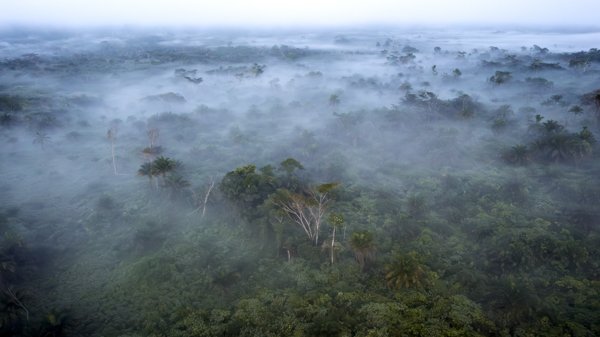
Science + Research
Photo © Gwenn Dubourthoumieu

Bonobos were the last great apes to be studied in the wild — and there's still so much we have to learn! Groundbreaking research is underway to discover more about bonobos. Local field teams have done outstanding work to habituate groups of bonobos to human presence, allowing scientists to observe them more closely.
Photo © Gwenn Dubourthoumieu
At Kokolopori, a long-term research program led by Martin Surbeck of Harvard University is shedding light on fascinating aspects of bonobo behavior. They are making discoveries on everything from intergroup cooperation to the influence of female alliances, and much more. The research program works in concert with local field teams and provides opportunities for aspiring Congolese scientists.
Photo © Frans Lanting
Beyond bonobos, the first-ever field observations of the rare Salongo Monkey (Cercopithecus dryas) were made at Kokolopori. BCI and Vie Sauvage have conducted a preliminary study—and we seek to renew the effort!
Vie Sauvage founder and president, Albert Lotana Lokasola recently earned his Ph.D. in herpetology at the University of Kisangani. He has initiated CongoHerp Lab, an exciting new study of reptiles, amphibians, and avian fauna at Kokolopori. Providing hands-on, practical opportunities for students and local participants, this program is making strides to learn more about important indicator species.
Photo © Russell Mittermeier
BCI also collaborates with the DRC Ministry of Scientific Research and the Max Planck Institute to conduct surveys and build the capacity of Congolese personnel. We provide training in biodiversity survey, participatory mapping, and bonobo monitoring techniques. The more we know about bonobos, the more we know how to help them.

Here are some of the articles that have been published as a result of research conducted at the Kokolopori Bonobo Reserve:
Liran Samuni and Martin Surbeck. 2023. “Cooperation across social borders in bonobos.” Science, 382, 6672, Pp. 805-809.
Leveda Cheng, Liran Samuni, Stefano Lucchesi, Tobias Deschner, and Martin Surbeck. 2022. “Love thy neighbour: behavioural and endocrine correlates of male strategies during intergroup encounters in bonobos.” Animal Behaviour, 187, Pp. 319-330.
Liran Samuni, David Lemieux, Alicia Lamb, Daiane Galdino, and Martin Surbeck. 2022. “Tool use behavior in three wild bonobo communities at Kokolopori.” American Journal of Primatology, 84, 1, Pp. e23342.
Stefano Lucchesi, Leveda Cheng, Tobias Deschner, Roger Mundry, Erin G Wessling, and Martin Surbeck. 2021. “Better together? How intergroup associations affect energy balance and feeding behavior in wild bonobos.” Behavioral Ecology and Sociobiology, 75, 1, Pp. 1-17.
Surbeck M, Coxe S, and Lokasola AL. 2017. Lonoa: The Establishment of a Permanent Field Site for Behavioural Research on Bonobos in the Kokolopori Bonobo Reserve. Pan Africa News 24(2).
Lokasola, A.L. 2014. PRELIMINARY ECOLOGICAL RESEARCH ON CERCOPITHECUS DRYAS AT KOKOLOPORI BONOBO NATURE RESERVE, CENTRAL CONGO BASIN. Consortion Congo 2010, 1st International Conference on Biodiversity in the Congo Basin. Kisangani
Georgiev AV, Emery Thompson M, Lokasola AL, and Wrangham RW. 2011. Seed predation by bonobos (Pan paniscus) at Kokolopori, Democratic Republic of the Congo. Primates 52(4):309-314.
Additional publications may be found on Dr. Surbeck’s research website.



